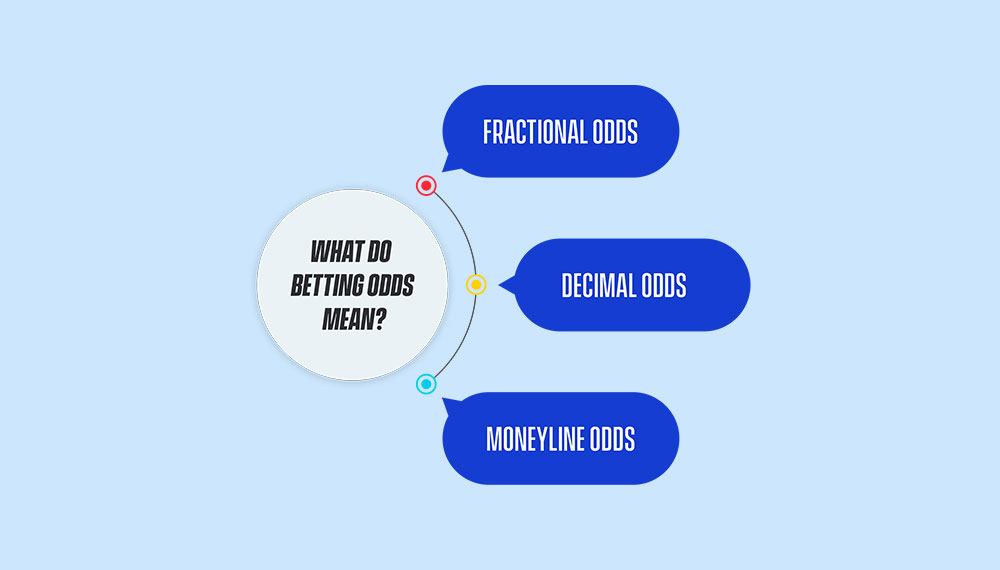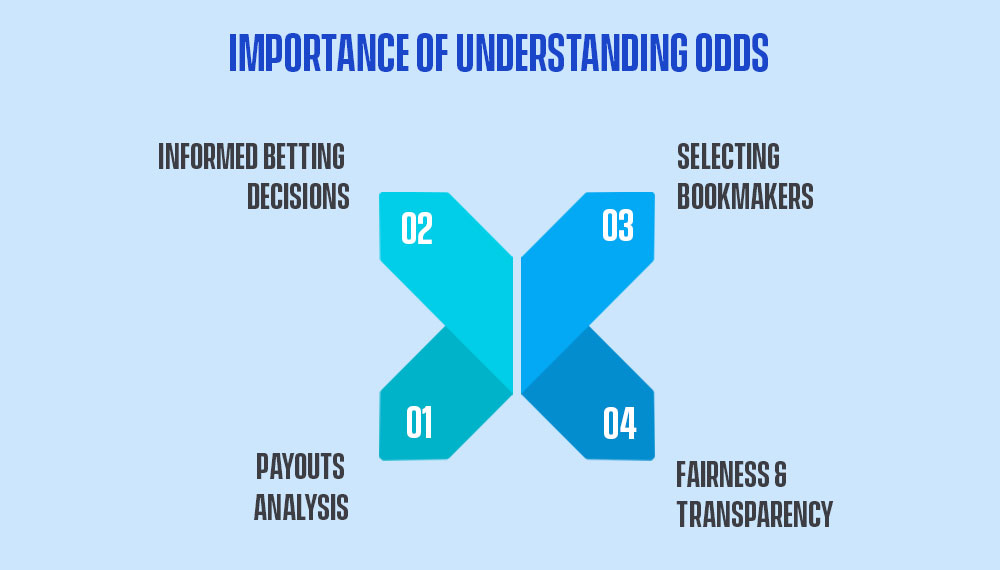

What Do Betting Odds Mean?
Odds come in various formats, with three of the most common being fractional, decimal, and moneyline. Each type has its regional preference and utility, which differs in its way of representation but yields the same results at the end. The numbers that appear alongside each match or event may seem cryptic at first, but once you grasp their meaning, you’ll unlock a wealth of possibilities for strategic and profitable betting.


Fractional Odds
As the name suggests, these odds are written and represented in the form of fractions such as ⅕, 2/7, and so on. Having its highest popularity and utility in the United Kingdom and nearby regions, fractional odds are also known as British Odds.

Decimal Odds
Widely used in Europe and therefore called European odds, decimal odds use decimal forms to highlight the underdog and favourite. These odds show the total potential return, including your initial stake. For example, 6.00, 1.50, 2.75 and so on.

Moneyline Odds
Moneyline odds let users understand how to win $100 using a specific wager or how much you would win for a $100 bet. Also known as American odds, these are represented with a positive sign or a negative sign such as +200, -150, and so on. For instance, +200 indicates that you could win $200 on a $100 bet, while -150 suggests you need to bet $150 to win $100.
Importance of Understanding Odds

Informed Betting Decisions
When placing bets, having familiarity with the odds understanding can help punters bet more strategically and logically. Understanding betting odds is therefore important to identify the ‘value bets’ and make hedging bets.

Selecting Bookmakers
Ever thought of why certified odds feeds are important and how to identify the ones? Well, a good grab of odds knowledge is never less to understand the basics and therefore to be able to compare which bookmaker site is helping you with the best odds and winning opportunities.
Payouts Analysis
Understanding sports betting odds takes you to the core mathematics part as well, which means you can enhance your catch on the calculation of odds and profits. No doubt, quick odds learning can help you learn to calculate your payouts with every bet, thus keeping you ahead in the race of betting.
Fairness & Transparency
Different bookmakers may offer different odds for the same event. Understanding odds enables you to compare odds across various sportsbooks and find the best value for your bets.
Interested For Player Attraction
& Business Popularity?
Calculating Payouts
Moneyline Odds
Moneyline odds showcase how much you need to wager to win $100 or how much you'd win for a $100 stake. To explain using an example, say an event’s odds have been represented as (+300, -200). The positive number on the money line implies the ‘underdog’ whereas the negative number belongs to the ‘favourite’.
Bets with a greater implied probability are assigned more negative values. For instance, if you place a bet at odds of -200, you would need to stake $200 to make a profit of $100.
Conversely, bets with a lower implied probability are assigned positive values. For instance, a bet with odds of +300 would yield a $300 profit on a $100 wager.

The positive value signifies that these are "plus money" odds, resulting in a greater profit than the wagered amount.
Fractional Odds
When you divide the larger number by the smaller number, as in the case of 2/1, the odds will yield a higher payout than the original wager. Conversely, when the smaller number is divided by the larger number, as in 1/2, the odds will result in a lower payout than the initial bet.
For instance, odds of 2/1 imply a payout that's three times the original amount wagered, equating to a 200% return. If you were to bet $100 at these odds and win, your profit would be $200. In contrast, odds of 1/2 would pay out only 50% of the initial stake, resulting in a $50 profit for a $100 bet.

There can be times when you get to see the fractions with denominators other than 1 such as 9/2 or 13/4. Here, the calculation remains the same i.e. you multiply the wager by the indicated fraction. For instance, odds of 9/2 translate to a payout that's 4.5 times the bet amount. Thus, a $100 bet at 9/2 fractional odds would yield a $450 profit. On the other hand, a $100 bet at 2/9 odds would result in a $22.22 profit.
Decimal Odds
Decimal odds provide a straightforward numerical value by which you can multiply your wager to determine your winnings (profit) and your total returns (profit plus your initial stake).
For decimal odds (e.g., 4.00), multiply your stake by the decimal odds to calculate the payout. Payout = Stake * Decimal Odds.
For instance, if you place a $100 wager with decimal odds of 4.00, your return would be $400 ($100 multiplied by 4.00): this includes a $300 profit and the initial $100 stake.
Similarly, a $100 bet with decimal odds of 1.50 would yield $150: a $50 profit in addition to the original $100 wagered.

Read More Blogs from Diverse Categories
GammaStack: Your Certified Odds Provider
When it comes to finding a reliable sports betting odds provider, look no further than GammaStack. Our comprehensive suite of services caters to all your sports betting needs, offering accurate and up-to-the-minute betting odds that are custom-made or even integrated by third parties for a wide range of sports and events. We understand the critical role that odds play in the world of sports betting, and our expert team ensures that you have access to the most competitive and dynamic odds on the market. Whether you’re a seasoned bettor or new to the game, GammaStack’s user-friendly platform and advanced odds calculation methods provide you with a competitive edge. With our top-notch services, you can make more informed betting decisions and maximise your chances of success. Choose GammaStack as your sports betting odds provider and experience the difference in your betting journey.
FAQs
Sports betting odds represent the probability of a particular outcome in a sporting event, which is used to calculate potential winnings.
Odds are typically expressed in three formats: Moneyline (American), fractional (UK), and decimal (European).
In moneyline odds, a minus sign (-) indicates the favoured team or outcome. It represents the amount you need to bet to win $100.
The plus sign (+) in moneyline odds represents the underdog. It shows how much you can win on a $100 bet.
Fractional odds indicate the profit relative to the stake. For example, 3/1 means you would win $3 for every $1 wagered.
Decimal odds show your potential total payout, including both profit and the original stake. For instance, 3.00 means a $1 bet would return $3 in total.
To calculate payouts, you can use online converters or formulas to switch between moneyline, fractional, and decimal odds.
Odds are influenced by factors such as team performance, injuries, weather conditions, public sentiment, and historical data.
Favourites typically have lower odds in all formats, while underdogs have higher odds. Identifying them helps you assess risk and potential return.
Odds providers use various algorithms and statistical models to calculate odds based on factors like team performance, historical data, and market demand.
Reputable odds providers offer accurate and up-to-date odds. It's crucial to choose a trusted provider to ensure fair and reliable odds.












 Rising Star Award
Rising Star Award
 Premium Usability Award
Premium Usability Award


